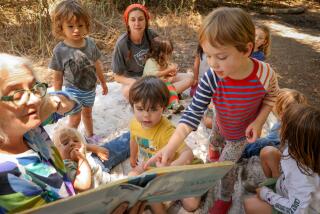Creativity Prized in ‘Reggio’-Style Preschools
- Share via
At tiny tables, in tiny chairs, the pupils do the talking at Stephen S. Wise Temple Nursery School and the teachers take the notes.
There, in cheery classrooms high atop Mulholland Drive on Los Angeles’ Westside, students’ words are recorded, transcribed, laminated and displayed--evidence of activities at school but also indicators of how the children are developing and proof for them that what they say has worth.
It is an approach that tests teachers’ creativity and their sensitivity to their students. And it comes from Italy.
Ever since a 1991 Newsweek article named Reggio Emilia’s municipal nursery schools as the best preschools in the world, that affluent northern Italian town has been visited by thousands of educators looking to copy the “Reggio” approach.
The co-director of Wise preschool toured the Italian campus four years ago and then began incorporating “Reggio” at the $6,500-a-year preschool of 245 students, who are ages 3 to 5 and mostly from Jewish families.
“This is the approach that touches not just my mind but my heart and my creative juices,” said Dafna Presnell, Wise’s co-director.
Several other Southern California schools also claim to have adopted, and adapted, the philosophy, where beautiful surroundings are prized, children’s words are revered, groups do the work and the day is designed to be unpredictable.
Developed when Italy lay ravaged by World War II, the curriculum of Reggio Emilia’s public preschools is described by educators as “negotiated” or “emergent.” Children’s interests and talents guide each day’s work and often prompt projects that can last weeks or months.
For example, when students at Wise were studying Thanksgiving, they seemed very attentive in their drawings to the number of buttons on Pilgrims’ clothing. That gave their teacher the idea to incorporate buttons--along with zippers, clasps, snaps and other fasteners--into a math lesson. In another class, two students’ insistence at snack time on eating dessert first prompted a lesson on nutrition.
Children who attend the preschools in Italy “understand how groups work, and they come out of these schools with a disposition to learn and a curiosity about the world,” said Ben Mardell, a researcher on a Harvard University team that has recently published a book examining Reggio Emilia’s schools.
Reggio schools in the United States tend to cater to an affluent crowd. The cachet of all things Italian--in toys, strollers and schooling--appeals to some yuppie parents.
Some American schools are more faithful to the Italian philosophy than others, says Alise Shafer, director of Evergreen Community School in Santa Monica.
“It’s really a philosophy, so it can’t be learned in a day or a year or even five years,” said Shafer, who has been using the Reggio approach at her preschool for 12 years.
American visitors often marvel at the uncluttered elegance of Reggio Emilia’s classrooms, flooded with natural light and decorated with flowers. American teachers often return to their own schools, plunk a few daisies in a blue vase and boast they are a Reggio school. The Italians dismiss these as “blue-vase schools.”
“The classrooms are gorgeous ... and on your first trip, it’s really hard to see past that,” said Shafer, who has visited Reggio Emilia four times and will close her school for a week in May to take her staff there. “People tend to just see the environment, so they go out and buy a few light tables, a couple of mirrors and plants and say, ‘We’re doing the Reggio approach.’ ”
Although flowers and vases can be found at both Wise and Evergreen, the preschools have advanced beyond Reggio’s most superficial hallmarks. Both schools place unusually high value on students’ observations and ideas. Evergreen teachers use digital video cameras to record children’s conversations; after school they are used to evaluate reasoning and identify interests that might guide future activities. Wise’s teachers also document their students’ words, which are reviewed by the school’s directors and posted with the children’s artwork on the walls.
“I’m looking for essential ideas and creativity in thinking and the depth of the thinking,” said Barbara Joffe, Wise’s other director. “It’s not about what is actually said but what it represents.”
So if a group of students decides the Pilgrims landed in Los Angeles, that becomes the reality, at least for a while. And if a boy describes a “leeb,” when he means a leaf, that’s “writed” down too.
At Evergreen, several students’ curiosity about gravity prompted the formation of “The Gravity Committee” to discuss why objects fall to the ground and stay there. And what was the dominant theory after three months of daily, transcribed discussion in Shafer’s office? Pinpricks in the sky deliver this force to every household.
“Our goal is never to teach children the facts,” Shafer said. “The goal is for them to engage in high-level thinking, so it doesn’t really matter where it ends up.”
To anyone who thinks that sounds ridiculously permissive, Wise’s Presnell points out that the children aren’t even in kindergarten yet. As they move on to elementary schools, they will learn the Pilgrims found Massachusetts, with all its leaves.
Parents are encouraged to visit the classrooms. For them, the documentation on display fills out a child’s answer to the dinner-table question, “What did you do at school today?”
“We get such a sense of what is going on in the classroom,” said Stephanie Sukert, who has had three daughters attend Wise’s preschool. “You can see everything that they’ve been doing.”
More to Read
Sign up for Essential California
The most important California stories and recommendations in your inbox every morning.
You may occasionally receive promotional content from the Los Angeles Times.










